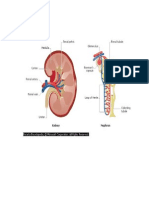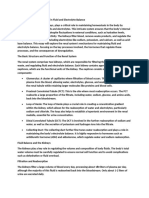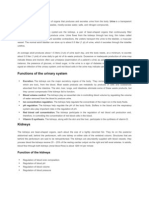Anatomy Kidney
Anatomy Kidney
Uploaded by
Herbie MilbyCopyright:
Available Formats
Anatomy Kidney
Anatomy Kidney
Uploaded by
Herbie MilbyCopyright
Available Formats
Share this document
Did you find this document useful?
Is this content inappropriate?
Copyright:
Available Formats
Anatomy Kidney
Anatomy Kidney
Uploaded by
Herbie MilbyCopyright:
Available Formats
The Human Kidney Structure and Function
The Anatomy and Physiology of the Kidneys
One of the most complex, beautifully “engineered” organs of the human body, the kidneys perform several essential tasks including the excretion
of waste products, the maintenance of homeostatic balance in the body and the release of important hormones. To achieve this, human kidneys
have a highly developed, superbly refined anatomy and physiology.
Location and Basic Structure of the Kidneys
The kidneys are located near the vertebral column at the small of the back; the left kidney lying a little higher than the right. Each is identical in
structure and function. They are bean-shaped, about 10 cm long and 6.5 cm wide. Each kidney comprises an outer cortex and an inner medulla.
The kidney is supplied with oxygenated blood via the renal artery and drained of deoxygenated blood by the renal vein. In addition, urine
produced by the kidney as part of its excretory function, drains out via narrow “tubules” and the ureter, in turn connected to the bladder.
The Nephron
The main functional unit of the kidney is the nephron. There are approximately one million nephrons per kidney. The role of nephrons is to make
urine by:
Filtering blood of small molecules and ions such as water, salt, glucose and other solutes including urea. Large “macromolecules” like
proteins are untouched.
Recycling the required quantities of useful solutes which then re-enter the bloodstream. (A process called reabsorption)
Allowing surplus or waste molecules/ions to flow from the tubules/ureter as urine.
Filtration and Reabsorbtion in the Kidneys
During progress through the nephron, some solutes like sodium chloride, potassium and glucose are reabsorbed, along with water, back into the
bloodstream. This maintains a correct balance of these chemicals within the blood, assisting blood pressure regulation, for example. The filtration
and reabsorbtion of glucose within the kidneys also helps to maintain correct levels of vital blood sugars. When this regulation breaks down very
serious health consequences can follow.
Urea and uric acid are nitrogen containing waste products from metabolic processes in the body. These substances are potentially toxic and are
partially excreted by the kidneys to maintain good health. Interestingly, of the filtrate which enters each nephron from the blood, only about 1%
actually leaves the body as urine because of the various reabsorbtion mechanisms driven by osmosis, diffusion, and active transport.
Tubular Secretion in the Kidneys
Another, less familiar, mechanism for urine production in the kidneys is tubular secretion. Specialised cells move solutes directly from the blood
into the tubular fluid. For example, hydrogen and potassium ions are secreted directly into the tubular fluid. This process is “coupled” or balanced
by the re-uptake of sodium ions back into the blood.
Tubular secretion of hydrogen ions, augmented by control of bicarbonate levels, is important in maintaining correct blood pH. When the blood is
too acidic (acidosis) more hydrogen ions are secreted. If the blood becomes too alkaline (alkalosis), hydrogen secretion is reduced. In maintaining
blood pH within normal limits (about 7.35–7.45) the kidney can produce urine with pH as low as that of acid rain or as alkaline as baking soda!
The Kidney as an Endocrine Gland
In addition to its excretory and homeostatic roles, the kidneys also release two important hormones into the blood. These are:
Erythropoietin which acts on bone marrow to increase the production of red blood cells
Calcitriol which promotes the absorption of calcium from food in the intestine and acts directly on bones to shift calcium into the
bloodstream.
Finally the kidney produces the enzyme renin, an important regulator of blood pressure
You might also like
- Worksheet Chapter 6Document42 pagesWorksheet Chapter 6kevin fajardoNo ratings yet
- Med Surg QuestionsDocument103 pagesMed Surg Questionsapi-385335081% (21)
- Fluid Therapy at Your Fingertips - Rashmi DattaDocument1 pageFluid Therapy at Your Fingertips - Rashmi DattaVasu Devan0% (1)
- Pediatric Endocrinology: A Practical Clinical GuideDocument870 pagesPediatric Endocrinology: A Practical Clinical GuideELYANNo ratings yet
- Anatomy and Physiology: Location and Basic Structure of The KidneysDocument3 pagesAnatomy and Physiology: Location and Basic Structure of The KidneysarnnieNo ratings yet
- Blood Supply of The Urinary Excretory System: AnatomyDocument3 pagesBlood Supply of The Urinary Excretory System: AnatomyJhe CaselNo ratings yet
- Urinary System Updated 1Document29 pagesUrinary System Updated 1owitinicole115No ratings yet
- Hemodialysis: Carina Joane Villareal-Barroso, R.N.,M.NDocument108 pagesHemodialysis: Carina Joane Villareal-Barroso, R.N.,M.NJune BarsNo ratings yet
- HEMODIALYSISDocument108 pagesHEMODIALYSISDan™100% (2)
- Introduction To Excretion in Human BodyDocument11 pagesIntroduction To Excretion in Human Bodyvurn5665No ratings yet
- Introduction To Excretion in Human BodyDocument11 pagesIntroduction To Excretion in Human Bodyvurn5665No ratings yet
- The Human Excretory System Functions To Remove Waste From The Human BodyDocument2 pagesThe Human Excretory System Functions To Remove Waste From The Human BodyrawatanandNo ratings yet
- KidneyDocument5 pagesKidneyecijakaNo ratings yet
- The Urinary SystemDocument37 pagesThe Urinary SystembalialkoushikNo ratings yet
- Tutorial Renal SystemDocument5 pagesTutorial Renal SystemManesa ManeshaNo ratings yet
- Chronic Kidney Disease Case PresDocument32 pagesChronic Kidney Disease Case Presnnaesor_1091No ratings yet
- Kidney and Kidneys Function 1Document5 pagesKidney and Kidneys Function 1nogakojasmrdiNo ratings yet
- KidneysDocument5 pagesKidneysRazanrazaNo ratings yet
- Introduction To Excretion in Human BodyDocument8 pagesIntroduction To Excretion in Human Bodyvurn5665No ratings yet
- KidneyDocument14 pagesKidneypromisearinzechi4No ratings yet
- Anatomy of The KidneyDocument7 pagesAnatomy of The KidneyArgie Arguson IINo ratings yet
- Biology Excretion NotesDocument8 pagesBiology Excretion NotesAshleigh JarrettNo ratings yet
- Excretion ExcretionDocument7 pagesExcretion ExcretionWaleed Bin KhalidNo ratings yet
- Urinary SystemDocument29 pagesUrinary SystemRuwan WijesooriyaNo ratings yet
- Excretion HSBDocument9 pagesExcretion HSBNahuuma SmithNo ratings yet
- The Renal SystemDocument53 pagesThe Renal SystemDarvey LongaraNo ratings yet
- Anatomy and PhysiologyDocument17 pagesAnatomy and PhysiologychardiginNo ratings yet
- Excretory SystemDocument2 pagesExcretory SystemMichelle RotairoNo ratings yet
- Urinary SystemDocument11 pagesUrinary Systemdheeraj jhaNo ratings yet
- Anatomy Explorer: Click To Read More BelowDocument10 pagesAnatomy Explorer: Click To Read More Belowzahwa dhiyanaNo ratings yet
- Function of The Urinary SystemDocument7 pagesFunction of The Urinary SystemMary EnsomoNo ratings yet
- BIOLOGY NOTES ExcretionDocument7 pagesBIOLOGY NOTES ExcretionAubreyNo ratings yet
- Urinary SystemDocument14 pagesUrinary SystemCharli ParachinniNo ratings yet
- 0610 Biology EXCRETIONDocument27 pages0610 Biology EXCRETIONMunir LakhaNo ratings yet
- Anatomy & Physiology: The Urinary SystemDocument5 pagesAnatomy & Physiology: The Urinary SystemSheena Arnoco ToraynoNo ratings yet
- Excretion and OsmoregulationDocument20 pagesExcretion and OsmoregulationJewel JosephNo ratings yet
- Kidneys Function TestDocument17 pagesKidneys Function TestJustine ChibuyeNo ratings yet
- Anatomy & Physiology of The Respiratory SystemDocument5 pagesAnatomy & Physiology of The Respiratory SystemDianne Dulay VillanuevaNo ratings yet
- 12.1 Waste Excretion and Equilibrium: Anatomy of The Urinary SystemDocument4 pages12.1 Waste Excretion and Equilibrium: Anatomy of The Urinary SystemVivian TangNo ratings yet
- The Urinary SystemDocument11 pagesThe Urinary SystemwaplNo ratings yet
- Anatomy and PhysiologyDocument3 pagesAnatomy and PhysiologyMarielle Leyva AycaydeNo ratings yet
- ExcretoryDocument31 pagesExcretoryJevin IndaNo ratings yet
- Chapter 6Document3 pagesChapter 6John ErickNo ratings yet
- Urinary SystemDocument80 pagesUrinary SystemLuis Gabriel JumamilNo ratings yet
- Hepatobiliary System: Anatomy & PhysiologyDocument22 pagesHepatobiliary System: Anatomy & PhysiologyMargaret Xaira Rubio Mercado100% (1)
- 3.1 Excretory SystemDocument6 pages3.1 Excretory SystemreddyapdscNo ratings yet
- 6 ExcretionDocument11 pages6 ExcretionAnasatcia Mcpherson 9c FNo ratings yet
- Water-Salt Metabolism in The Body: Intracellular Fluid CompositionDocument6 pagesWater-Salt Metabolism in The Body: Intracellular Fluid CompositionFranklyn Favour FlorenceNo ratings yet
- Kidney SystemDocument21 pagesKidney SystemMuntasirNo ratings yet
- KidneysDocument24 pagesKidneysknowledgezone8242No ratings yet
- Regulation of Internal EnvironmentDocument8 pagesRegulation of Internal Environmentabbeypraise03No ratings yet
- Lab 8 Bi309Document8 pagesLab 8 Bi309SanahKumarNo ratings yet
- Human Physiology Ii: School of BiochemistryDocument15 pagesHuman Physiology Ii: School of Biochemistrykeerthana t reddyNo ratings yet
- The Renal SystemDocument10 pagesThe Renal SystemWahyu Purbo PangestiNo ratings yet
- Kidneys: LocationDocument6 pagesKidneys: LocationRanjana Das BhowmickNo ratings yet
- The Role of The Renal System in Fluid and Electrolyte BalanceDocument4 pagesThe Role of The Renal System in Fluid and Electrolyte Balanceaspec.th.j.lNo ratings yet
- Ansci Narrative Report Source DraftDocument18 pagesAnsci Narrative Report Source DraftJennlyn LaiNo ratings yet
- HomeostasisDocument10 pagesHomeostasisSiddhesh YadavNo ratings yet
- LiverDocument3 pagesLiverrahniNo ratings yet
- Urine Formation: Mohamad Ashraf IsmailDocument13 pagesUrine Formation: Mohamad Ashraf IsmailAshraf Moby100% (1)
- The LiverDocument7 pagesThe LiverBarrameda NegideasisNo ratings yet
- An ADocument2 pagesAn Acrazy0214No ratings yet
- Notes Grade: IX Subject: Biology Unit: 12 Topic: Excretion ObjectivesDocument21 pagesNotes Grade: IX Subject: Biology Unit: 12 Topic: Excretion Objectivespraneeth satishNo ratings yet
- Renal Reflections: Exploring the Marvels of Nephrology: The Intricate Ballet of Kidney Functions UnveiledFrom EverandRenal Reflections: Exploring the Marvels of Nephrology: The Intricate Ballet of Kidney Functions UnveiledNo ratings yet
- Name of The Organization: Udemy: Lovely Professional University GEN - 231 ProjectDocument18 pagesName of The Organization: Udemy: Lovely Professional University GEN - 231 ProjectSaurav kumarNo ratings yet
- CH 8 Digestive System: StructuresDocument18 pagesCH 8 Digestive System: StructuresBheru LalNo ratings yet
- Adult and Elder I. Nursing Care PlanDocument6 pagesAdult and Elder I. Nursing Care PlanteresapazNo ratings yet
- Meta OmicsDocument22 pagesMeta OmicsAldo VázquezNo ratings yet
- KetoMonitor Extension Group TalkDocument22 pagesKetoMonitor Extension Group Talkmevlut gunalNo ratings yet
- Plab 1 Mock 5th March 2017Document35 pagesPlab 1 Mock 5th March 2017RabeeyaNo ratings yet
- Health Effects of Androgen Abuse - A Review of The HAARLEM StudyDocument6 pagesHealth Effects of Androgen Abuse - A Review of The HAARLEM StudyEmile VeenstraNo ratings yet
- What Causes Rigor Mortis?: Science, Tech, MathDocument6 pagesWhat Causes Rigor Mortis?: Science, Tech, MathNicholas BoampongNo ratings yet
- Acid Base Disorder Practice Problems Notes by Giuls 30Document6 pagesAcid Base Disorder Practice Problems Notes by Giuls 30marcoNo ratings yet
- Antidiabetic Agents-WPS OfficeDocument4 pagesAntidiabetic Agents-WPS OfficeSourajyoti GoswamiNo ratings yet
- A Systematic Review On The Pre-Clinical Study of Cephalandra Indica and Gymnema Sylvestre in Diabetes Mellitus Type 2Document7 pagesA Systematic Review On The Pre-Clinical Study of Cephalandra Indica and Gymnema Sylvestre in Diabetes Mellitus Type 2International Journal of Innovative Science and Research TechnologyNo ratings yet
- Lecture 1 GIT Nutrient Digestion and Absorption QBDocument4 pagesLecture 1 GIT Nutrient Digestion and Absorption QBKero amgedNo ratings yet
- Poultry Health and ManagementDocument359 pagesPoultry Health and ManagementAbubakar Tahir Ramay100% (1)
- Formulation, Development and Evaluation of Instant Whitening Face WashDocument18 pagesFormulation, Development and Evaluation of Instant Whitening Face WashDanisa AzzahraNo ratings yet
- Chromatin RemodelingDocument13 pagesChromatin RemodelingShera NeazNo ratings yet
- Human Nutrition SyllabusDocument3 pagesHuman Nutrition Syllabusthirumalaidadamma100% (1)
- Control: GIT FunctionsDocument6 pagesControl: GIT FunctionsS ANo ratings yet
- Folkesundhedsprojekt KopiDocument108 pagesFolkesundhedsprojekt KopiOlga zivanovicNo ratings yet
- Cold Chain Presentation Erick 2Document26 pagesCold Chain Presentation Erick 2Airep OiralihNo ratings yet
- Organs SystemDocument4 pagesOrgans SystemJan Paul SantosNo ratings yet
- Jadwal Ekb 2024Document5 pagesJadwal Ekb 2024Jansen BNo ratings yet
- Quantitative Analysis Nelson's AssayDocument4 pagesQuantitative Analysis Nelson's AssayJenelle Jane Quilaneta25% (4)
- 9 NeurotransmittersDocument48 pages9 NeurotransmittersYolanda Ulmi100% (1)
- MCQ Hap-II, Bp201tDocument39 pagesMCQ Hap-II, Bp201tANUJ DEVNo ratings yet
- Icu Acquired WeaknessDocument8 pagesIcu Acquired WeaknessSrinivas PingaliNo ratings yet
- Final Exam-Clinical Biochemistry S.Y. 2022-2023Document17 pagesFinal Exam-Clinical Biochemistry S.Y. 2022-2023Frankenstein MelancholyNo ratings yet

























































































